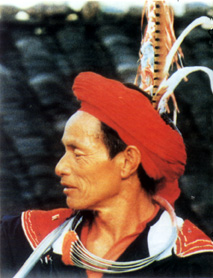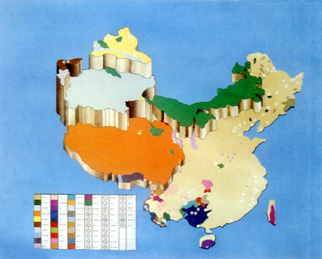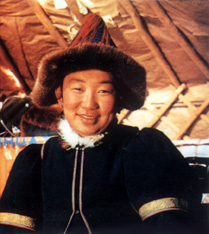 Ceremonial dress from South Kwangtung Province.
Ceremonial dress from South Kwangtung Province.
On the 19th of February, 1988, there was an exhibition in the pavilion of Lou Lim Ieok Park of traditional costumes and handicrafts of the fifty five ethnic minorities of the People's Republic of China. This was the result of a project begun twenty seven years ago with the intention of creating an Ethnographical Centre. The purpose of this exhibition can be better understood by looking at the age-old links which unite China and Portugal, by looking at the population of Macau (which is largely Chinese) and by looking at the cultural wealth visible in the incredible variety within this great Chinese nation. Finally, this exhibition will contribute to the strengthening of the bond of friendship between the two peoples during the transition period.
Let us now turn to the ethnic minorities of the People's Republic of China. Take any kind of flower, a peony for example. While there are many different kinds of peonies, they all belong to the same genus. This can be seen as a symbol for the ethnic minorities. There is one variety of peony which is more common and which can be found anywhere and there is a panoply of other varieties which are rarer and fewer in number. When they are combined, they form a single "nation" just like a jigsaw puzzle composed of different coloured pieces (cf. map).
The ethnic minorities are characterized by highly individual value systems, often based on race, language and religion, which differ from those of the remainder of the country. The different minorities are in harmony with each other and are proud of preserving their differences at all costs. Over the centuries there have been resistance movements which, either peacefully or through force, have reacted against the state for trying to subjugate or control them.
China has fifty six recognised ethnic groups. Fifty five of them are minorities while the remaining one, the Han, comprises 94% of the total population or approximately nine hundred million people spread throughout the country. The minorities are composed of seventy million people who are descended from such nations as Inner Mongolia and Manchuria and nomad tribes who live on the cold banks of the "Black Dragon" River or in the humid mountains of Yunnan.
Divided into geographical regions, the ethnic minorities can be classified as follows.
The Northeast
1) TheManchu minority - half of the four and a half million members of this group live in the province of Liaoning.
2) The Korean minority - around one million, eight hundred thousand people who live principally in Kirin Province although they can also be found in the provinces of Heilungkiang and Liaoning.
3) The Hezhe minority - around one thousand, four hundred people living on the river banks at T'unghua, Hailung and Wushuli.
4) The Mongol minority - two and a half million members living in the steppes of Inner Mongolia.
5) The Dawo minority - ninety four thousand members spread throughout Inner Mongolia, Heilungkiang and Sinkiang-Uighur and principally in Molidahua.
6) The Dauer minority - nineteen thousand members in Inner Mongolia and Heilungkiang
7) The Orokan minority - four thousand, one hundred members living in Heilungkiang.
 Map showing China's ethnic minorities.
Map showing China's ethnic minorities.
The Northwest
8) The Hui minority - around seven and a half million members of this Muslim group living throughout this part of China.
9) The Dongxiang minority - three hundred thousand members of this Islamic group living in Ningsia and Sinkiang-Uigur.
10) The Tu minority - one hundred and fifty thousand members living mainly to the east of Lake Tsinghai to the south of Kunlun Shan.
11) The Sala minority - seventy thousand members of whom more than 80% live in the Tsinghai district.
12) The Baoan minority - around nine thousand members living in Kiangsu Province to the west of Kiangsha district.
13) The Yugu minority - approximately ten thousand members who live in Kiangsu Province.
14) The Uigur minority - six million members living in the Sinkiang-Uigur region.
15) The Hazak minority - around nine hundred and seven thousand members living in the Sinkiang-Uigur region.
16) The Kirghiz minority - over one hundred and thirteen thousand members living in Sinkiang-Uigur.
17) The Xibo minority - around eighty three thousand members, most of whom live in Sinkiang-Uigur.
18) The Tajik minority - twenty six thousand members living in the Silk Road zone.
19) The Uzbek minority - twelve thousand people who live in Sinkiang-Uigur Province.
20) The Russ minority - three thousand members of this minority, similar to the Russians of the Soviet Union, living in Sinkiang-Uigur, more specifically in the Yili zone.
21) The Tatar minority - around four thousand members of this Islamic minority living in Sinkiang-Uigur Province.
The Southwest
22) The Tibetan (Zang) minority - around four million members who inhabit principally the southwestern and northwestern regions of China, living on plains at an extremely high altitude.
23) The Menba minority - around six thousand, two hundred members who live in southern Tibet at the foot of the Himalayas.
24) The Luoba minority - around two thousand members neighbouring on the Menbas, living in southeastern Tibet.
25) The Qiang minority - around one hundred thousand members living in or around the provinces of Szechwan, Yunnan, Kweichow and Kiangsi.
26) The Yi minority - a group living in Yunnan and Szechwan Provinces.
27) The Hani minority - a group living in Yunnan Province.
28) The Lisu minority - a group living in Yunnan Province.
29) The Bai minority - around one million, two hundred thousand members concentrated in the hinterlands, mountains, plateaux and valleys of Yunnan Province.
30) The Dai minority - eight hundred thousand members living in the southwestern region of Yunnan Province.
31) The Wa minority - three hundred thousand members who live between the Rivers Lan and Lu in Yunnan Province.
32) The Lahu minority - three hundred thousand members living in Yunnan Province.
33) The Naxi minority - two hundred and forty thousand members who live in the mountains and highlands of Yunnan Province.
34) The Jingpo minority - ninety three thousand members living in a high-altitude region in southwest China.
35) The Bulang minority - around fifty eight thousand members who live in the southwest of Yunnan Province.
36) The Achang minority - around twenty thousand members who live principally in the Tewan region of Yunnan Province.
37) The Pumi minority - around twenty four thousand members who live in the region of Yunnan and surrounding areas.
38) The Nu minority - around twenty three thousand members living on the banks of the River Nu in the uplands to the northeast of Yunnan Province.
39) The Benglong minority - ten thousand members who are concentrated into the Dawang region of Yunnan Province.
40) The Dulong minority - between four to five thousand members living on the banks of the Dulong River in the northeast of Yunnan Province.
41) The Jinuo minority - ten thousand people living in the Szekiang Panne region of Yunnan Province.
42) The Miao minority - around five million members distributed throughout Kweichow, Hunan, Kiangsi, Szechwan, Kwangtung and Hopeh.
43) The Buyi minority - two million members who inhabit the Wenkwei plateau in Kweichow Province.
44) The Dong minority - one million members living in Kweichow Province.
45) The Shui minority - three hundred thousand members spread through Kweichow Province.
46) The Gelao minority - fifty three thousand members who live in certain parts of Kweichow and Kiangsi Provinces.
The South and Southwest
47) The Zhuang minority - fourteen million members living in Kiangsi Province.
48) The Yao minority - nearly one million members living throughout thirty districts and provinces with the majority in Kiangsi Province.
49) The Mulao minority - ninety thousand members living in the Lushang region of Kiangsi Province.
50) The Maonan minority - thirty eight thousand members of whom 70% live in the tropical region of Kiangsi Province.
51) The Jing minority - around ten thousand members who live in the South of China.
52) The Tujia minority - three million members who live in the west of Hunan Province.
53) The Li minority - eight hundred thousand members who inhabit principally Hainan Island.
54) The She minority - thirty six thousand members who live in Southeast China.
55) The Gaoshan minority - one and a half thousand members who live in Southwest China in Fukien Province and Taiwan.
There are several points which stand out from this list of ethnic minorities. On the one hand, there is the vastness of the Chinese nation and the variety of the people who make up this nation. On the other hand, there are the differences between these people, the result of geographical factors influencing climate and therefore clothing and customs.
The Chinese government has taken measures to preserve the cultural identities of the ethnic minorities which can be divided into the following four moves: the non-application of current compulsory family planning regulations;
promoting study of the country's official language (Mandarin) while encouraging the study of each minority's specific language;
increases of social benefits and advances in technology;
assistance in complying with the regulations for compulsory education and encouraging further study.
These measures are aimed at modernization and development based on the principle of respect for variety within the unity of the nation.
The question now lies in how to bring progress to these diverse and highly individual communities without provoking a situation of cultural adaptation. As we know there are always at least two options: to impose through force, which is political ethnocide, or, on the other hand, to plan a change of attitudes. The Chinese leaders have chosen the second option, involving a slower change but also a more consistent and lasting one which reflects a humane, respectful approach. This kind of change is the most effective as it is through persuasion that the greater benefits of "progress" and changes in attitude will be achieved without losing any of the values which have shaped the character of the minorities over the centuries.
Science and technology will be introduced while at the same time preserving and revitalizing the adherence to the traditions of their forefathers (customs, dress and handicrafts, religion and rituals, music, folklore and festivals) which are what give meaning to their lives and maintain their cultural identity.

Heavy clothing which the Mongols use to guard against the strong Siberian winds.
start p. 98
end p.